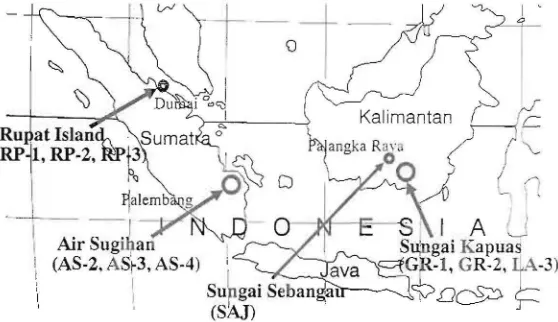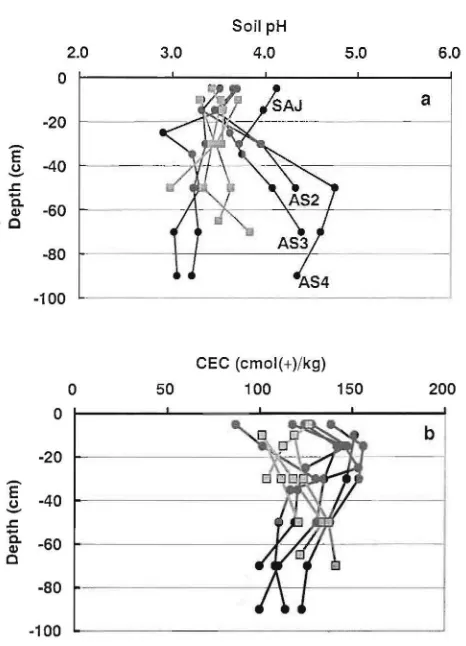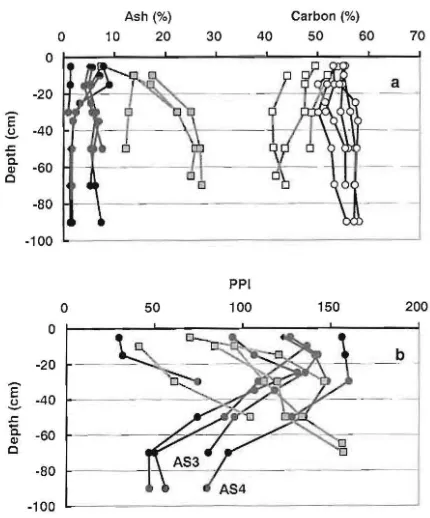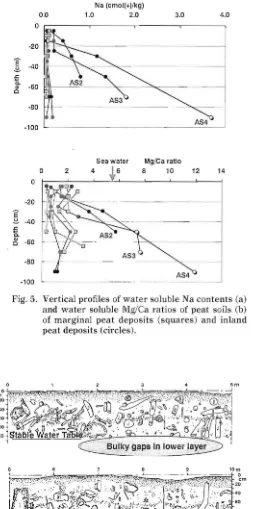TROPICS
セゥヲヲェゥhyp@
Vol. 14
No.1
October 2004
The Japan Society of Tropical Ecology
セaL@ 1±t-J+-
AI:j " ,TROPICS Vol. 14 (1) Issued August 31, 2004
Evidence of sea water Boron in the lower layers of tropical woody
peat
Koyo YONEBAYASHI", Hidekazu YAMADA", Atsushi SUZUKll), Munehiro EBATO" and SyaifuJ AI\f\\'AR2)
"Soi l Chemistry, Graduate School of Agriculture, Kyoto Prefectural Un iversity, Shimogamo, Sakyo, Kyoto 606-8522 Japan "Department of Soil Science, Faculty of Agricul ture, Bogor Agricultural University, Bogor, Indonesia
ABSTRACT For the assessment and proper use of tropical peatlands, chemical problems such as nutrient deficiencies and toxicities
should be solved. The concentration of the essential trace element boro n, which is in tropical peat soil, is very low (about 1/10 of the cultivated mineral'soil in Japan), however, in layers below 40 cm depth of inland peat B is abundantly fixed. The effect of sea water was estimated, because the water soluble Na content in these layers was high and the water soluble Mg/Ca ratio in them was as high as that of sea water. Therefore, in these layers the B appea rs to be fixing the high levels of B in the sea water. Various gaps have developed in the lower layer of the inland peat indicating that the sea water can infiltrate with the pressure of the fl ood-tide.
Key words: tropical woody peat, inland peat, lower peat layer, boron, sea water, Mg/Ca ratio
Tropical peat consists of plant residues of former forests in varying degrees of decomposition. Tropical peatland contains a
greater diversity of woody plant species than that found in temperate regions. The latter developed from grass plants such as
reeds, sedges and Sphagnum. In tropical peat, well-preserved woody materials are commonly found within the matrix of dark
brown amorp hous materials. The properties of tropical peat are based on several factors (Driessen, 1978; Bouman and Driessen, 1985), including the nature of the original plants, wood content, degree of decomposition, the supply of inorganic
solutes, the environmental conditions, peat stratification, and compactions.
The total area of tropical peat swamps or tropical peatlands in the world amounts to about 30 Mha, two thirds of which are in Southeast Asia (Driessen, 1978) . The peatlands are mostly in Sumatra, Kalimantan, and West Papua. Over 8 Mha of
Indonesia 's peatlands are deeper than 2 m. Inland peat deposits with greater than 15 m depth are found in the high altitude
peatlands (Rieley et aI., 1992). Many of them appear to have been formed in the early and middle Holocene era (Neuzil,
1997).
Large areas of coastal lowland peatlands have been exploited for agricultural development, and the difficulties of their
large-scale development are widely known. The low fertility (Chew et al., 1978; Yonebayashi et al., 1994) and polyphenolic
toxicity (Driessen and Suhardjo, 1976) are among the factors causing agricultural production failure. The optimum utilization
of peatlands depends on its characteristics.
Boron is one of the esse ntial trace elements for vascular plants. It is important in the metabolism of saccharides and synthesis of the cell walls of plants. The range of B concentrations that are optimum for plant growth, is narrow. B deficiency a'1d toxicity are common. B is essential for pollen tube growth (Marschner, 1986) and B deficiency reduces the root growth
r<He (Bohnsack and Albert, 1977).
In general, B in soil can be divided into three categories (Keren and Bingham, 1985): (1) B in primary minerals, such as
セ.•wm aline (borosilicate minerals), (2) B adsorbed by soil constituents, such as clay minerals, hydroxide of Al and Fe, organic
'·.aLl er. and (3) B in soil solutions such as boric acid and borate ions.
We previously reported that the available B content in tropical peat soils CYonebayashi and Yamada, 2000) is markedly
' 0 Lh an that in mineral soils. It is not clear whether this stems from the low solubility of soil B or from the low content of
'2:
B in peat soils.h [h e peat soil ecosystems, many nutrient elements circulate between peat and plants, and the nutrients are repeatedly
セZiィコエG、N@ The regeneration of plants becomes possible in a closed ecosystem such as peatlands CYonebayashi et al., 1997) . A
:-c·...-s:.Jppl y of nutrient elements is not provided in deep peat, because plant roots do not reach the mineral soil layer under
132 Koyo YONEBAYASHI, Hidekazu YAMADA, Atsushi SUZUKI, lVIunehiro EBATO, and Syaiful ANwAR
there is little heavy metal run-off. Although B should combine with the cis-hydroxyl groups of the polysaccharide in the peat
deposit by coordination bonding, thereby becoming stabile, no study has reported this.
MATERIALS AND METHODS
The chemical s tatus of B in tropical peat was examined in samples collected from three peat depos its in Indonesia comprising 3 sites at Air Sugihan basin (AS-2, AS-3, AS-4) in South Sumatra, 3 sites in Rupat Island, and 4 sites at
Sg.Sebangau (SA]) and Sg. Kapuas basin (GR-l, GR-2, LA-3) in Central Kalimantan, as shown in Fig.l.
Fig. 1. Location of sampling sites of peat deposits.
To determine the total B in organic samples quantitatively, the explosive reaction generated in fusion with sodium peroxide must be prevented. A method for total B analysis without the explosive reaction was developed by decomposing
th e major organic substances with dry combustion and fusing the residue with sodium peroxide. B was measured by colorimetry. Mannitol soluble B was determined from an extract with 2% mannitol containing 0.05 M acetate buffer (pH 4.5)
solution heated at 100°C for 15 min. B was meas ured using ICP-AES equipment.
The total organic carbon content of peat sample was determined by the dry combustion method using an NC analyzer
(Sumigraph NC-800) after pretreatment with a dilute HCl solution to remove carbonates. Ash (mineral) content was
determined by dry combustion overnight at 440°C. Kaila's pyrophosphate index (PP!) was determined by the method
described in a previous paper (Anwar
et at.,
2004) . A 500 mg peat sample was extracted with 50 mL of 0.025MNa-pyrophosphate for 18 hr. Ten mL of the extract was diluted to 50 mL. The absorbance at 550 nm was determined, multiplied by 100, and the value that is equivalent to Kaila's PPI was obtained. Cation exchange capacity (CEC) and concentrations of
exchangeable bases (Ca, Mg, K, and Na) were measured after successive extraction with 1M セュュッョゥオュ@ acetate at pH 7.0
and subsequently 10% NaCI solutions (Thomas, 1982). The amount of NH, replaced by Na was determined by titration with
O.OIM HCI solution after steam distillation, whereas the contents of exchangeable bases were determined by atomic
absorption spectrometry (Shimadzu, AA-640-01). Water-soluble bases (Ca, Mg, K, and Na) were extracted with water at a
soil to water ratio of 1:5 (Rhoades, 1982) and determined by atomic absorption spectrometry.
RESULTS AND DISCUSSION
The samples collected near the margin or the edge of the peat deposits were termed marginal peat, while the samples
collected from more inland areas were regarded as inland peat (Table 1). In general, inland peat is deeper than marginal peat. Soil pH of peat ranged from 2.9 to 4.8, and there was no significant difference in pH between inland peats and marginal peats.
However the pH of the lower layer of Air Sugihan peat was significantly high (more than 4) shown in Fig. 2a. CEC of peat
soil ranged from 87 to 156 cmol( +) kg"', and there was no significant difference in soil CEC between inland peats and
[image:3.611.197.476.229.390.2]133
I ANWAR Evidence of sea water Boron in the lower layers of tropical woody peat
-1e peat
Table 1. Study sites and their features
Peat Distance Distance
Sample Peat deposits/
Province deposit from sea from river Land use
No Name of site type (km) (km)
lonesia
;ites at AS-2
{\S-3 AS-4 RP-l RP-2 RP-3 GR-l GR-2 LA-3 SA] Air Sugihan Air Sugihan Air Sugihan Rupat Island Rupat Island Rupat Island Garung Garung Lamunti Setia Alam ] aya
South Sumatra South Sumatra South Sumatra Riau Riau Riau Central Kalimantan Central Kalimantan Central Kalimantan Central Kalimantan Inland Inland Inland Inland Marginal Inland Marginal Marginal Marginal Inland 14.5 18.5 12 9 2.5 9.5 83.5 87 93 115 5 7 7 3.5 1 3.5 2 2.5 3 7 Cultivation
Tree/shruba)
Tree/s hruba)
Rubber tree Forest Forest Forest Forest Forestb ) Forest
I sodium
mposmg
iured by (pH 4.5)
analyzer
tent was : method
25M
Na-セオャエゥーャゥ・、@
:ations of at pH 7.0
Ition with ,yatomic
vater at a
セ@ sa mples pnal peat. inal peats.
セ c@ of peat peats and
"Abandoned land after about 5 years of cul ti vation. "'Newly cut and fell ed forest (about 1 year)
Soil pH
2.0 3.0 4.0 5.0 6.0
o
a
20I
-40.r:. 0.. Q) 60 · 0 -80 100
CEC (cmol(+)/kg)
o
50 100 150 200o
iセMMMMMMセMM MMMM セMMMMMMセMMMMセ@20 I b
I
.r:.g.
o 40 60 -80 100Fig. 2. Vertical profiles of pH (a) and CEC (b) of marginal peat deposits (squares) and inland peat deposits (circles).
セ@
[image:4.611.80.457.117.303.2] [image:4.611.138.371.357.680.2]134 Koyo YONEBAYASHI, Hidekazu YAMADA, Atsushi SUZUKI, Munehiro EBATO, and Syaiful ANwAR
The features of the inland peat show very low ash content of 9% or less, and 50% or greater carbon
content, compared with the marginal peats in all layers, shown in Fig. 3a. The ash component, which
is mainly in the marginal peat, consists of inorganic components such as clay minerals derived from
mineral soils around the peatlands. However, inland peat has nearly no inorganic components. The inland
peat has relatively low levels of nutrient elements,
since these element ions are not supplied from the inorganic component (Driessen, 1978).
Kaila's pyrophosphate index (PPl) (Kaila, 1956) was determined and used as a key measure of the
degree of decomposition of peat soils. As seen in Fig.
3b, the PPI of the inland peats tended to decrease with soil depth, however, the value of the PPI near the surface layer differs by peat soil. In contrast, the
PPI of the marginal peat tended to increase with soil
depth. It was recently shown that the pattern of
lignin alteration (Anwar et ai., 2004) described by the
acid/aldehyde ratio of ligninderived phenols, displayed the same pattern as the PPI profile . The
results suggested that in inland peat there is a more anaerobic history of alteration in the lower layers
compared to marginal peat (Anwar et al., 2004) .
Marginal peat areas were drier or occasionally
aerated, were considerably influenced by
environmental factors, such as the chemical quality of the surrounding formation and enrichment with
fluvial materials, and were commonly exposed to more intensive microbial attacks (Driessen, 1978) .
The total B content in all lay ers of marginal peat was small, amounting to 10 mg kg" or less, with an average of 4.5 mg kg", which corresponds to about
1/10 of that of mineral soils that are heavily manured
in Japan . The total B in the inland peat was als o very small between 0 to 40 cm depth, at 5 mg kg" or less.
However, the quantity increased to greater than 10
mg kg" in three layers which were deeper than 40 cm of the AS3 and AS4 samples (Fig. 4a). The
mannitol soluble B content in most layers of inland peat was small at le ss than 0.7 mg kg", with an
average of 0.27 mg kg ', except for two layers which were deeper than 40 cm of inland peat AS4 sample
(Fig 4b). It was also less than 0.5 mg kg' in all layers of the marginal peat and the average was 0. 14 mg kg'.
The watersoluble Na content of all layers of
marginal peat was very small, amounting to 0.1 cmol
(+) kg" or less. The watersoluble Na quantities of the inland peat were also small between 0 to 40 cm
Ash (%) Carbon (%)
0 10 20 30 40 50 60 70
0
a
20
E
40.!!..
.<:
ii
II> 60
c
80
100
PPI
0 50 100 150 200
E
.!!.. .<: ii II> cFig. 3. Vertical profiles of ash and carbon contents as 0 20 b 40 -60 80 100
E
.!!.. .<: ii II> cE
.!!.. .<:a
c"
percentages of peat soils (a) and Kaila's pyrophosphate indices (PPI) of peat soils (b) of marginal peat deposits (squares) and inland peat deposits (circles).
Total B (mg/kg)
0 10 20 30 40
0 a 20 40 60 80 100
Mannitol soluble B (mg/kg)
2.0
0.5 1.0 1.5
[image:5.611.351.566.91.350.2]20 40 60 80 100 b
[image:5.611.349.561.457.735.2]40
135
II ANwAR
o
セッッ@
.ents as {aila's
Is (b) of IUd peat
(a) and t soils of land peat
t:pth, at 1.2 cmol (+) kg' or less. However, the
,lantity increased to greater than 1.2 cmol (+) kg"
:l three layers which were deeper than 40 cm of AS
and AS4 samples (Fig. Sa). The Mg/Ca ratios of
: heir aqueous extracts were markedly higher than
:b e other peat samples (Fig. Sb). The water soluble ,.Ig/Ca ratio of the layer below 40 cm of inland peat \\'as greater than,S.S6, though for the marginal peat it
\\as less than 3. The Mg/Ca ratio of sea water (Kitano, 1992) is constant at S.56, and the mean
value of the Mg/Ca ratio of river water (Kitano, 1992) worldwide is estimated at 0.38. Therefore, the peat
which had a watersoluble Na content of the lower
layer greater than 1.2 cmo l (+) kg ' and a Mg/Ca
ratio greater than 5.S6, must have had contact with
sea water.
As far as the cations which are adsorbed to peat
are concerned, the exchangeable Ca!Mg ratio was less than S.9, even in the samples that had a
water-soluble Mg/ Ca ratio between 5.S6 to 12. The exc hangeable Mg/Ca ratio which shows the
composition of t he adsorbed divalent ca tion was between that of the Mg/Ca ratio of seawater and that
of river water. There was a highly positive
correlation between the exchangeable Mg/Ca ratio (X) and the watersoluble Mg/Ca ratio (Y), in the
inland peat, as follows: Y
=
1.73X+
0.13,r
=
0.88,Because Ca2
+ is more strongly adsorbed to the humic
substances than Mg2
+, and the stability constant of
humic substances complexes with Ca2 + is higher
than Mg2+ (Fla ig et al., 1975), Mg 2+ dissociate in
water more easily than Ca2+ and the watersoluble
Mg/Ca ratio is larger than the exchange Mg/Ca ratio.
There was a highly positive correlation between
the total B content and the watersoluble Na content and the Mg/Ca ratio, in the inland peat. It is known
that the B concentration of sea water is markedly higher than that of river water. The B concentration
in all sea water (Kitano, 1992) is constant at 4.7 mg L", and the mean value of the B concentration of
river water (Durum and Haffty, 1963) is 0.01 mg L". This suggests that the B which has accumulated in
some inland peat lower layers (AS3 and AS4 samples) is derived from sea water.
_'.ldence of sea water Boron in the lower layers of tropical woody peat
Na (cmol(+)!kg)
0.0 1.0 2.0 3.0 4.0
0 20
E
40 セ@ .l: C. Q) 60 CI AS3 80 AS4 100 8Mg/Ca ratio
10 12 14
[image:6.611.250.508.79.588.2]0 20
E
セ@ 40 .l: C. セ@ 60 80 AS4 100 Fig. 5. Vertical profiles of water soluble Na contents (a) and water soluble Mg/Ca ratios of peat soils (b) of marginal peat deposits (squares) and inland peat deposits (circles).o 1 2 3 4 5 m
en;:
セセ[IG\ᄋBセ
••·d..
ZッG[ Z[ェZセGAZᄋZBエ
|GNセ セᄋZᄋ| BNヲZᄋᄋᄋイオ
GOH [GZᄋ
Zᆴセ
GZゥス Zy[ セMPPᄋゥZG
Z GZ セGZセ
ᆴ
Q@
4<l II Y,
N^uセ
j@ G@ BM
セ
セョi@ UセGNセセセ
B@ ... 131 6ijセセGHェj。Zqoッセ
" U' · セ@
80 ;. ,
PZセセ⦅@
:,Gセセ G FᄏNセj
e.,.dJ,..,GセB@ N^セ G@
"tf"-'" . -g'GB@ oGセ@
80:\\ ,R " . " セ@ • , . . " ,,' .,.
. l:C/
'.§
L セ@
セ
,• G@
1-"," ,
J.4
lJ 「 G " I
100 Stable Water Ta '., . ; . . . . '. I · 6 J
セ Lスセ
l
",-BUlkY gaps in lower layer '
5 •
セG Zセ Z|セセセZGセ
セQセ
セ セセGIjPEゥ
Hセ セセセᄋ ZZ@
ᄋNZ[ N@ Gセ セセ G G
L[GZゥュ
W
Uti_GゥGIセセ@ DsMヲjーGMNNNッNGLヲ
BLセLLᄋ@ ョBGLBG [B\GGG セG[ZOGZスGGGセj_@
.,"";/'
セ[G@
• . • :
セ@ セャ
セ@
c:l
r\セ@
0 r;jJ " , 0/1<n •
I
"""" "'r
-,.."",
1 ' ... 0 --v " セi@ l O e r 80
StUMP»
Oセ ^ |@ .: .. 0" : .' セ@ LB@ ,:' 0' :"<:' a ': 100, /. , ,-' -
セッエ
ウ@
pile up Ina lattice struc;ure' 120-Fig. 6. Typical profile of tropical woody peat (Sg, Talau Peat Research Station, Mukah, Sarawak)
It is unclear how sea water infiltrated the lower layers of inland peat. Figure 6 shows the peat profile examined in the
field of the Sg. Talau Peat Research Station in Sarawak, and shows typical features of tropical woody peat. Many morphological features of Southeast Asian tropi cal woody peat profiles have been exa mined in detail. In all inland peat, large
amounts of various sized woody fragments are buried in deep layers below the stable water table, usually at 40 to 60 cm depth. The branches, twigs, trunks, and roots of trees have piledup in a latticelike structure in the lower layer of the inland
[image:6.611.247.496.455.621.2]136 Koyo YONEBAYASHI, Hidekazu YAMADA , Atsushi SUZUKI, Munehiro EBATO, and SyaifuJ ANwAR
Sea water appears to have infiltrated through the bulky gaps of lower peat from the pressure of the floodtide. This invasion
and retreat of sea water in the lower peat layers appears to follow the ebb and flow of the tides. Various base ions in the sea water are adsorbed with the cation exchange units in the peat materials, and are extracted in the water dissolving part of the
cation by dissociation.
In general, B is adsorbed by the clay minerals and hydroxide of Al or Fe, and organic substances in the soil (Keren and
Bingham, 1985). The inland peat contains hardly any clay minerals or Al hydroxide. Sea water derived B appears to have
adsorbed to the iron hydroxide and/or the organic substances, especially carbohydrates, by forming boratediol complexes. B complexed with cisdiol of carbohydrates can be easily extracted in mannitol solution. The mannitol soluble B content in the
marginal peat was small, averaging 7.4% of the total B content. The mannitol soluble B content of inland peats of all layers
except for two layers deeper than 40 cm of AS4 sample, averaged 14% of the total B content. It averaged 12% of the total B
content in the lower layers of AS4 sample. Therefore, it is unlikely that boratediol complexes selectively adsorbed the B in the lower layers of inland peat. Because B(OH)3 is the dominant species in low pH (Keren and Bingham, 1985) tropical peat,
it can be assumed that most of the B adsorbed on the surface of the peat as the molecule of B(OH)3.
ACKNOWLEDGEMENT This work was supported by the Japan Society for Promotion on Science.
REFERENCES
Anwar, S., Kosaki, T. & Yonebayashi, K. 2004. Cupric oxidation products of tropical peat soils. Soil Sci. Plant Nutr. 50: 35-43.
Bohnsack, C. W. & Albert, L. S. 1977. Early effects of boron deficiency on indole-acetic acid oxidase levels of squash root
tips. Plant Physiol. 59: 1047-1050.
Bouman, S. A. M. & Driessen, P. M. 1985. Physical properties of peat soils affecting rice-based cropping systems. In: Soil
Physics and Rice, (N.C. Brady ed.), Inter. Rice Res. Inst., Los Banos, Philippines, 71-83.
Chew, W. Y., Williams, C. N. & Ramli, K. 1978. The effect of green manuring on the availability to plants of nitrogen in
Malaysian peat. Soil Bioi. Biochem. 10: 151-153.
Driessen, P. M. 1978. Peat soils. In: N. C. Brady (ed.), Soils and Rice, Inter. Rice Res. Inst., Los Banos, Philippines, 763-779.
Driessen, P. M. and Suhardjo, H. 1976. On the defective grain formation of sawah rice on peat. Soil Res. Inst. Bull. Bogor,
Indonesia, 3: 20-43.
Durum, H. & Haffty, J. 1963. Implications of the minor element content of some major streams of the world. Geochim.
Cosmochim.Acta 27: I-I I.
Flaig, W., Beutelspacher, H. & Rietz, E. 1975. Chemical composition and physical properties of humic substances. In: Soil
Components Vol. 1 Organic Components, (Gieseking, J. E. ed.), Springer-Verlag, N.Y., 132-139.
Kaila, A. 1956. Determination of the degree of humification in peat samples.]. Sci. Agric. Soc. Finland 28: 18-35.
Keren, R. & Bingham, F.T. 1985. Boron in water, soils, and plants. In: Advances in Soil Science, Vol. 1. (Stewart,
B.
A. ed.),Pp. 229-276. Springer-Verlag, N.Y.
Kitano, Y. 1992. Water Geochemistry, In: Encyclopedia of Earth System Science, Vol.4, Academic Press, 449-462.
Marschner, H. 1986. Mineral Nutrition of Higher Plants, 889pp. Academic Press, London.
Neuzil, S. G. 1997. Onset and rate of peat and carbon accumulation in four domed ombrogeneous peat deposits, Indonesia. In:
Biodiversity and Sustainability of Tropical Peatlands. (Rieley, J. O. & Page, S. E. eds.), Pp. 55-72. Samara Publishing
Ltd., Cardigan, U. K,
Rhoades, J.D. 1982. Soluble salts. In: Methods of Soil Analysis., (Page, A. L. et al. ed.), Part 2, Chemical and Mineralogical
Properties, SecondEd., Pp. 167-179. Madison, Wis.
Rieley, lO., Sieffermann, R.G., Fournier, M. & Soubies, F. 1992. The peat swamp forest of Borneo: Their origin,
development, past and present vegetation, and importance in regional and global environmental processes. Proc. 9th
Inter. Peat Congr. Uppsala , Sweden, 1: 78-95.
Thomas, G.W. 1982. Exchangeable cations. In: Methods of Soil Analysis, Part 2, Chemical and Mineralogical Properties, Second
Ed., (Page, A. L. et al. eds.), Pp. 159-165. Madison, Wis.
Yonebayashi, K. Okazaki, M., Kaneko, N., and Funakawa, S. 1997. Tropical peatland soil ecosystems in southeast Asia: Their
137 .• 'c of sea water Boron in the lower layers of tropical woody peat
iful ANwAR
invasion
セ@ the sea 3.ft of the
Page, S. E. eds.), Pp. 103111. Samara Publishing, Cardigan, U. K
,dJ ayashi , K, Okazaki M., Pechayapisit
J..
Vijarnsorn P., Zahari A.B. & Kyuma K 1994. Distlibution of heavy metalsam ong different bonding forms in tropical peat soils. Soil Science and Plant Nutrition., 40: 425434.
i.; bayashi, K & Yamada, H. 2000. Boron contents of tropical peat soils in southeast Asia. In: Proc. Int, Symp. Tropical
eren and Peatlands. (Iwakuma, T. et al. eds.), Pp. 4953. Hokkaido Univ., Sapporo, Japan.
; to have
plexes. B !nt in the
all layers
Je total B I the B in )ical peat,
1'.50:
35-uash root
s. In: Soil
itrogen in
,763779.
utl. Bogor,
Geochim.
!s. In: Soil
B. A. ed.),
lonesia. In:
Publishing
neralogical
e ir origin,
;. Proc. 9th
セ ゥ・ウL@ Second
Asia: Their ey,]. O. &
Received 14'hOct. 2003



